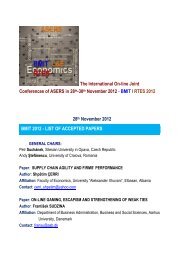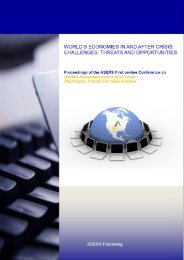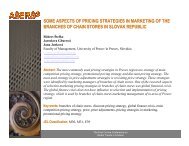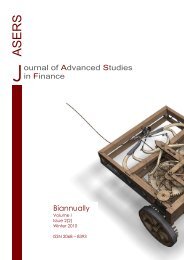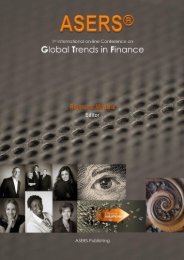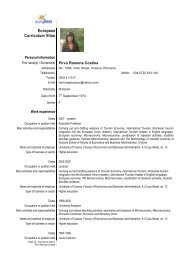Can Shift to a Funded Pension System Affect - ASERS
Can Shift to a Funded Pension System Affect - ASERS
Can Shift to a Funded Pension System Affect - ASERS
You also want an ePaper? Increase the reach of your titles
YUMPU automatically turns print PDFs into web optimized ePapers that Google loves.
Theoretical and Practical Research in Economic Fields<br />
Pesaran, Shin and Smith (2001) provide critical values for this bounds test from an extensive set of<br />
s<strong>to</strong>chastic simulations under differing assumptions regarding the appropriate inclusion of deterministic variables<br />
in the error-correction model (ECM) 14 . The investigation involves testing the existence of a long-run relation<br />
among national savings, private pension funds, and public pension provision and life insurance funds.<br />
The model in Equation (2) is more appropriately regarded as representing the equilibrium relationship in<br />
the long-run, but is unlikely <strong>to</strong> hold exactly in every single period. Hence a dynamic specification is required in<br />
order <strong>to</strong> allow the model <strong>to</strong> capture the short-run adjustment process without losing important information about<br />
the long-run equilibrium behaviour of the variables. This study uses an ECM with unrestricted intercept and no<br />
trend 15 . The empirical relationship of the error-correction model has the following general dynamic representation:<br />
p<br />
t 0 1 2 t1 1, i ti 2, i ti 1, i ti<br />
i1 i1 i1<br />
2, i ti 3, j j t<br />
i1 j1<br />
7<br />
p p p<br />
SAV T ecm Z SAV Z<br />
ε<br />
SAV D <br />
<br />
where α 0 is the drift component, T is the deterministic trend, ΔSAV t is the variation of national savings, Z t<br />
is a vec<strong>to</strong>r of pension variables (private pension funds, pay-as-you-go, life insurance funds), ecm t-1 is the<br />
equilibrium correction term (μ t ) given in Equation (2), D j are dummies (dummy1 <strong>to</strong> dummy4) as described in<br />
Section 4.2.2, with γ‟s as the long-run multipliers, β‟s as short-run dynamic coefficients, (p) as the order of the<br />
underlying ARDL-model (p), and ε t are white noise errors. This dynamic model shows that the movement of the<br />
variables in any period is related <strong>to</strong> the previous period‟s gap from long-run equilibrium. In other words, from<br />
Equation (3) whenever ΔSAV t turns out <strong>to</strong> differ from Z t-1 , some sort of adjustment must occur <strong>to</strong> res<strong>to</strong>re the<br />
equilibrium in the subsequent period.<br />
Following Pesaran, Shin and Smith (2001) we try <strong>to</strong> determine the proper lag length p in Equation (3) with<br />
and without a deterministic linear trend. Table 3, presents these results using the Akaike‟s, Schwarz‟s Bayesian<br />
Information Criteria (AIC and SBC) and the Lagrange Multiplier (LM) statistics for testing the hypothesis of<br />
residual correlation of order 1 and 4. The results of the AIC and SBC suggest the use of four lags or more, while<br />
and 2 (4) recommend the use of a lag order of four. Since it is of a particular importance for the validity<br />
2 (1) SC<br />
SC<br />
of the bound test the assumption of serially uncorrelated errors, for the sake of parsimony, we use the lag<br />
selection criterion with p=4.<br />
Table 3. Lag-length selection criteria<br />
With deterministic trend<br />
Without deterministic trend<br />
Lags AIC SBC 2 SC<br />
(1) 2 SC<br />
(4)<br />
AIC SBC 2 SC<br />
(1) <br />
2 SC<br />
(4)<br />
p=1<br />
p=2<br />
p=3<br />
p=4<br />
p=5<br />
p=6<br />
130.0160<br />
232.5858<br />
237.5847<br />
243.3617<br />
255.8904<br />
259.3507<br />
117.8423<br />
221.9565<br />
222.4325<br />
222.1945<br />
225.7176<br />
227.7391<br />
59.70<br />
5.288<br />
0.004<br />
4.195 <br />
0.319<br />
2.236<br />
70.69<br />
16.44<br />
14.20<br />
9.582 <br />
14.77<br />
7.326<br />
130.0170<br />
232.8846<br />
237.0085<br />
235.0044<br />
249.6885<br />
248.3567<br />
119.3650<br />
223.7738<br />
223.3715<br />
221.3969<br />
224.0416<br />
224.2717<br />
62.61<br />
6.433<br />
0.360<br />
3.413 <br />
2.317<br />
6.814<br />
75.27<br />
34.64<br />
33.22<br />
11.48 <br />
15.82<br />
10.61<br />
Notes: the lag order is selected on the basis of AIC and SBC and indicates the lag length choice according <strong>to</strong><br />
the two criteria respectively.<br />
Based on the previous discussion, we test for the absence of a long-run relationship between the national<br />
savings and the pension funds variables employing an F-test for the joint null hypothesis<br />
0 , under<br />
1,<br />
i 2, i<br />
<br />
the alternative hypotheses that there is a stable long-run level relationship between the aforementioned variables.<br />
(3)<br />
14 If the calculated test statistic (which is a standard F test for testing the null hypothesis that the coefficients on the<br />
lagged levels terms are jointly equal <strong>to</strong> zero) lies above the upper bound, the result is conclusive and implies that a long-run<br />
relationship does exist between the variables. If the test statistic lies within the bounds, no conclusion can be drawn without<br />
knowledge of the time series properties of the variables. In this case, standard methods of testing would have <strong>to</strong> be applied.<br />
If the test statistic lies below the lower bound, no long-run relationship exists.<br />
15 Pesaran, Shin and Smith, 2001, p. 296.<br />
20



